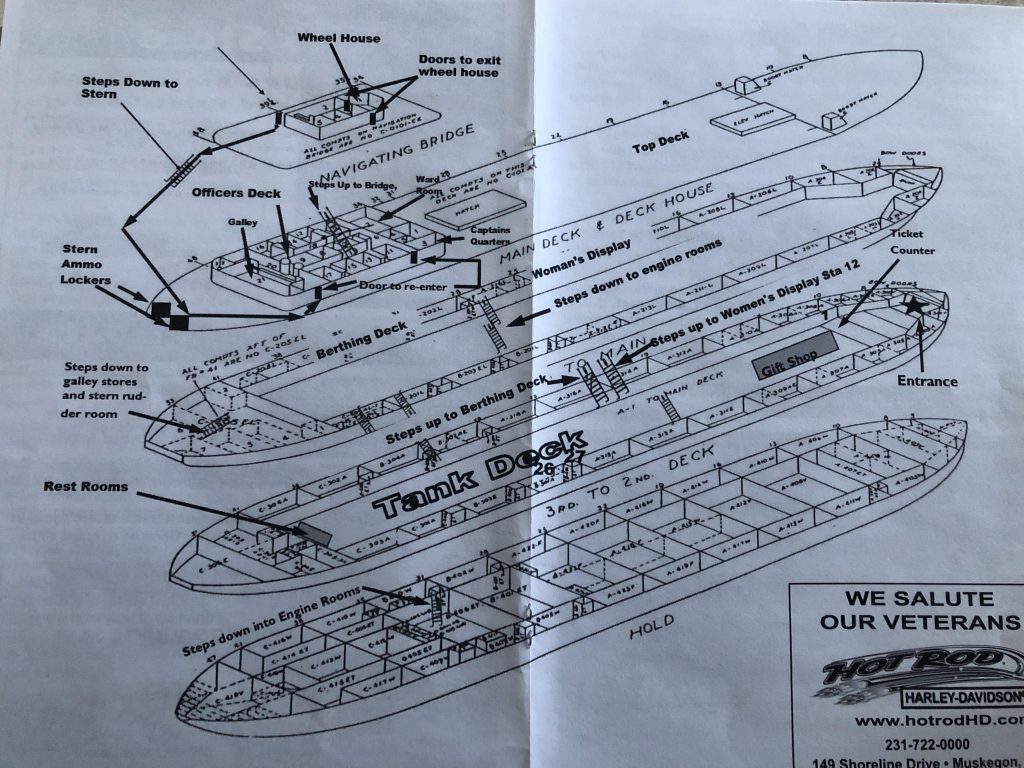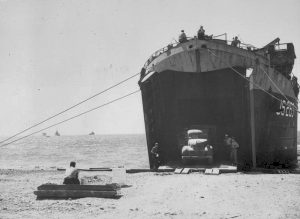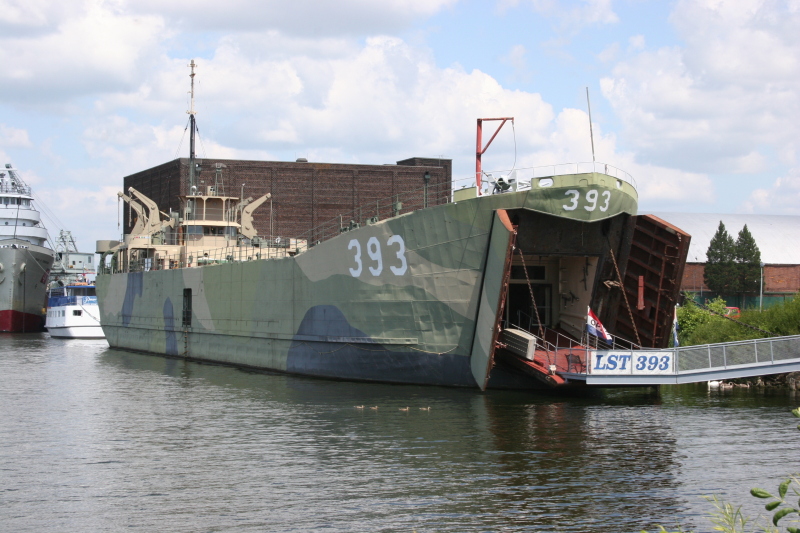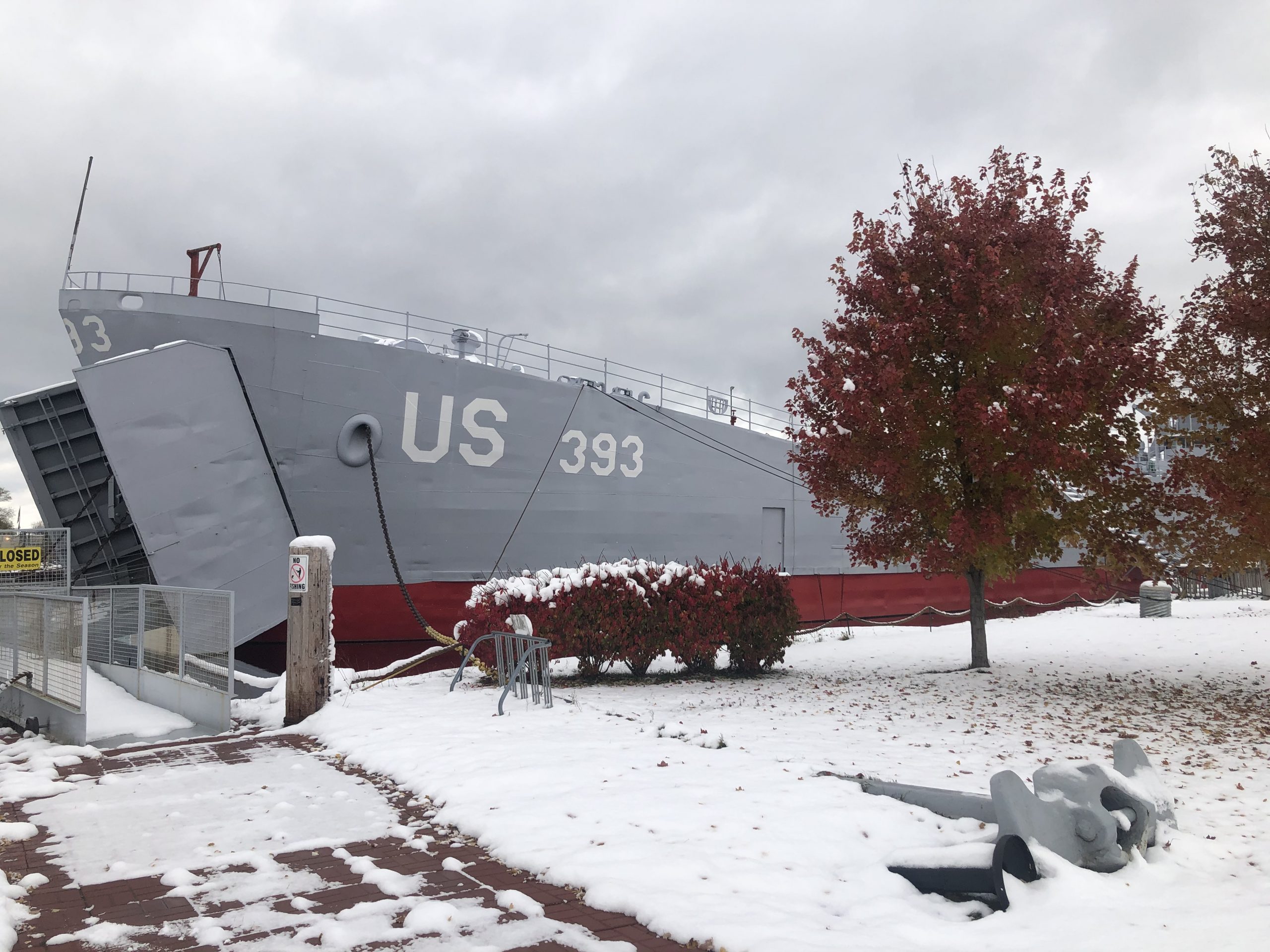The USS Landing Ship Tank 393 has had many roles and jobs throughout its career. During World War II, these ships were one of the largest shipbuilding innovations of its time. The ship had a modern ballast system that allows the ship to sit higher and lower in the water. This was done by pumping the water out of the system which would raise the ship allowing it to beach on land. This helped out greatly during wars to unload supplies. This technique can be seen when it was used in submarines at this time. This landing ship tank (LST) is one of the only two remaining in the United States. The other living USS landing ship tank is on the Ohio River in Evansville, Indiana. USS LST 325 is also now a museum and memorabilia ship like the LST 393. For World War II, more than 1,051 LSTs were built in three years with eighteen shipyards constructing, and 113 of them produced for Britain. Once the war was over, many of the ships were scrapped or sunk. In fact, only 26 of the ships were lost in action. This ship can be seen throughout history as a warship, a United States Highway, and nowadays a history museum.
The USS Landing Ship Tank was an ocean ship created for infantry divisions to invade by sea. The Landing Ship Tank was used to deliver troops, tanks, and assault vehicles. The United States was asked by Prime Minister Winston Churchill to design a ship large enough to travel the ocean, but efficient enough to deliver equipment and troops to different types of coasts. The USS landing ship tank is the smallest vessel the navy considered a ship. Anything smaller is considered a boat. The landing ship is 328 feet long and has a beamwidth of 50 feet. Beamwidth is the widest width the ship has. When they first wanted to construct the LST ships, they tried to assemble three tankers together. This test ship was used in operation torch landings in 1942. Once a design was accepted, through the Lend-Lease agreement, the Royal Navy asked for 200 LST’s to begin production. Once this happened, the first boat set sail in Newport News, Virginia, and the rest of the production Landing Ship Tanks started following four months after. Due to this high demand, steel industry plants shifted their focus to the ship production to help aid the military. When the boat was not carrying tanks, it could ship and house 500 military personnel. However, when the boat was carrying supplies, there would only be about 150 soldiers. When you calculate that out with 28 tanks on board, this meant crews of five-six men per tank. You can see that they need other ships and vehicles to bring troops other than just the landing ship tank. The landing ship tanks have five decks that all hold different responsibilities for the ship and its different jobs. The hold of the ship contains all the engine rooms. The drive shafts, electrical, and two diesel engines are found in the “basement” of the ship. The next level of the boat held all of the tanks and the only laundry room on the ship, and this level is known as the tank deck. Next, the berthing deck, is where the troops would sleep and wash up. The fourth deck up was known as the officer and galley deck, this is where the officers would rest and the troops would get in line for food. Finally, the top section was known as the navigation deck. This was where the radio room and chart room would be found. The USS Landing Ship Tank 393 was one of two ships to still have the original arrangement, so preserving this artifact is necessary to maintain the history. This ship allowed for different types of work depending on the need at the time.

The Birth of the Ship
The USS Landing Ship Tank 393 was set in motion in Newport News, Virginia on November 11, 1942. When a ship is launched into the water, it must go through the ceremonial ship launching and other traditions that are intended to give the ship good luck on its voyage. One major part of the ceremony is the tradition of christening a ship. When a ship is christened, a bottle of champagne is broken over the bow of the ship as it is launched and the name of the ship is spoken. To prepare a champagne bottle for christening, you must wrap the bottle in mesh and place red, white, and blue ribbons along the top of the bottle. This was done by the Purchase Department. When the ship was christened, this becomes the boat’s birthday so this means the LST 393 is now 77 years old. In the USS LST 393 museum, the honoring ribbon and pieces of the broken wine class can be viewed. These tokens were donated by Lucy Sorensen Pape, the 11-year-old girl who christened the ship. Lucy Pape was the daughter of L.R. Sorenson a yard assistant naval architect and shipbuilding executive. This ceremony took place at the Newport News Shipbuilding and Dry Dock Company. The day of the launch also happened to be on the same day as Veteran’s Day. This day of remembrance however was not picked as the same day as the boat launch on purpose. The date for Veteran’s Day was chosen as November 11th because that was the day an agreement with Germany was signed and ended World War I. Once the boat was launched and bid farewell, it had to pass all of its sea test trials before it could set sail for work in Europe. For the USS landing ship tank 393, its career had only just begun as a ship.
European Theater
Now that the USS landing ship tank 393 was ready for action, it set sail to provide aid in the European Theater of World War II. The landing ship earned three battle stars for its service during World War II invasions in Sicily, Italy, and at Omaha Beach. During its three years of service in the European Theater, the ship was known for making a powerful statement by swinging open its large doors at the end of the ship and releasing the tanks on the beaches. The LST’s most memorable service was at Omaha Beach in Normandy, France. The ship came in during the second day of the invasion. When visiting the ship, you can find the American flag that was flown on the day it landed on Omaha Beach. The boat would dock at the beach during high tide to deliver food, tanks, and ammunition to the troops already on the island. The landing ship took 30 round trips to the beaches along the coast of Normandy. The troops at Omaha Beach only came on board once to eat. This is because the boat has such a flat bottom that the waters were rough and they were so used to not eating that much that the soldiers were sick from a real meal. After supplies were unloaded, the boat would leave again before the tides lowered. During the war, the landing ship tank did more than delivering men and tanks, it also was designed to withstand the brodie system. This system allowed scout planes to take off and land on the ship without having a runway or a landing deck. This was able to be done with the help of a trolley and elevated cable. The scout plane would be lifted up to the trolley and would roll along the cable to pick up speed for takeoff. For landing, the plane would line up with the cable and would be reeled in like a fishing pole action until the plane slowed. At this time the German U-boats were controlling the Pacific Ocean, so adapting the brodie system helped protect other ships and was able to aid in the anti-submarine missions. After supplies were unloaded, the boat would leave again before the tides lowered. When the boats would take off to head to base in Britain, they would take back soldiers that needed to hospital care and prisoners of war. After its time spent in World War II, the USS LST 393 was sent to Texas to be repainted camo for the invasion of Japan. However, once finished, the boat did not get to see action because the atomic bombs ended the war before it could start. The USS LST 393 was later decommissioned on March 1, 1946 after traveling 51,817 nautical miles, transporting 3,248 vehicles, carrying over nine thousand soldiers, and delivering over five thousand prisoners. The trips of travel across the Pacific Ocean prepared the ship for its next job.

New Role as a Car Ferry
After the boat was decommissioned in 1946, the ship was sent to New Orleans, Louisiana to be painted black and sold. The Wisconsin and Michigan Steamship Company of Milwaukee bought the LST 393 to become a merchant ship, bringing cars from Detroit, Michigan to Muskegon, Michigan to Milwaukee, Wisconsin until 1973. During this new phase of work for the ship, it was given a new name of M/V Highway 16. The new car ferry did not change much to the existing warship. The only major change was the mess room turned into a place to play board games and have meetings. The berthing rooms stayed to allow crew members to sleep or rest during the trip across the Great Lakes. The USS LST 393 can only go 12 knots which equates to almost 14 miles per hour. If there are 252 nautical miles between Detroit and Milwaukee, this would take about 18 hours to arrive at the next destination in good weather. Soldiers would joke that the LST initials stood for large slow target, but the LST ships altogether suffered fewer losses compared to the number of operations that participated in. In Detroit, the ship would be loaded with Ford Motors and General Motors Corporation vehicles. Once it made it to Milwaukee, the LST would be unloaded and American Motors Corporation vehicles would be loaded on and sent back to Detroit. The M/V highway 16 did not have the budget to compete with the larger car companies in Detroit such as Ford, General Motors, and Chrysler and started to lose customers. Once Milwaukee was not able to keep up, the nautical highway interactions slowed soon causing the highway to close. At this time, US 16 was created on land that went from Muskegon to Detroit. After this period, the USS LST 393 was restored to its former glory and was stationed in Muskegon, Michigan.
Retirement
In 2000, a Muskegon museum group and the Michigan LST Association started to refurbish the LST 393 back to the original state. However, two years into the restoration the two groups ran out of steam and work stopped. Then in 2005, a new group gained permission from the owners at Sand Products Corporation to continue where the previous team had left off. The new group led by Dan Weikel and Bob Wygant spent most of their time cleaning and painting to bring the tour to a state that would be tourable. For the tours, the boat was painted back the camo color scheme that it adopted for the war against Japan. The biggest feat by this group was unwelding the bow doors at the end of the boat. This became the new entry to the museum and the doors had not been opened since the late 1940s. Recently, in 2015, the boat was repainted to the grey scheme that it was during World War II, and this was done to restore the boat to its former wartime greatness. The museum features exhibits with artifacts from the Civil War all the way up until the Iraq War. It also services as a museum about the landing ship tank itself. The Veterans Museum is a non-profit corporation that was designed to restore and preserve the one of only two LST’s remaining. It was also created to honor all of those who served in America’s branches of service for all eras and to educate the public about history. The landing ship tank also hosts corporate, social, and special events. Boy scout troops can sign up for trips to tour the ship and sleepover in the beds that past Americans slept in. This is a great experience for the troops to be put in soldiers’ footsteps for a day. Many boy scouts have said this trip was one of the most memorable nights of their journey with the troop. This is why the USS LST 393 board puts in so much effort to restore and maintain the artifact.

The LST still has some maintenance issues it needs to take care of to prevent wrecking the exhibits. During a private tour, the hoses were run outside to drain out water from the melting snow on the top deck. The leaking issue used to be far worse when the local firefighters would have to drain the water out of the ship when it started to sink. Since then the lowest deck was resealed when it was painted in 2015. When speaking with Scott Grant, the president of the board, the future of the ship and museum is looking to be placed on land to prevent any other leaking and to allow the paint to last longer. The two engines of the ship were last fired up in the late 1990s. Since this is quite recent, this shows the ship still has the potential to run again. The USS Landing Ship Tank 393 was one of two ships to still have the original arrangement, so preserving this artifact is necessary to maintain the history.
Primary Sources
- “USS LST 393 Ship” Newport News Shipbuilding and Drydock Company, 27 July 1942. Muskegon, Michigan.
- “USS LST-393 Information.” Historic Naval Ships Association Database, 14 May 2014.
- “LST 393 War Diary, June 1944.” Navy History, LST 393.
Secondary Sources
- Chen, C. Peter. “LST-Class Landing Ship.” World War II Database, April 2007.
- Sherman, Elizabeth B.. Beyond the Windswept Dunes: The Story of Maritime Muskegon. United States, Wayne State University Press, 2003.
- USS LST 393 Museum, “LST History.” LST 393 Preservation Association, 9 November 2019.
- Grant, Scott, “Personal Interview.” 9 November 2019.
Further Reading
- PeriscopeFilm. “LST STORY- Landing Ship Tanks” YouTube, 6 Nov. 2009.

